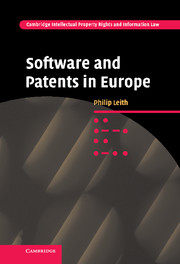Book contents
- Frontmatter
- Contents
- List of figures
- Introduction
- 1 Software as machine
- 2 Software as software
- 3 Policy arguments
- 4 Software patent examination
- 5 Holding the line: algorithms, business methods and other computing ogres
- 6 The third way: between patent and copyright?
- 7 Conclusion: dealing with and harmonising ‘radical’ technologies
- Index
- Cambridge Intellectual Property and Information Law
7 - Conclusion: dealing with and harmonising ‘radical’ technologies
Published online by Cambridge University Press: 22 July 2009
- Frontmatter
- Contents
- List of figures
- Introduction
- 1 Software as machine
- 2 Software as software
- 3 Policy arguments
- 4 Software patent examination
- 5 Holding the line: algorithms, business methods and other computing ogres
- 6 The third way: between patent and copyright?
- 7 Conclusion: dealing with and harmonising ‘radical’ technologies
- Index
- Cambridge Intellectual Property and Information Law
Summary
It is more difficult to reject a patent application than to grant a patent.
Introduction
This book began as an investigation into whether it was possible to find a mechanism to limit protection for software ‘as such’ – that is, whether there was an alternative to the relatively woolly concept of ‘technical effect’. The project involved immersion in patent applications, file histories, granted specifications, looking for an understanding of how it might be possible to apply that mechanism for setting the clear line across which the European patent system might not cross. This author's conclusion is that there is little real hope of drawing such a line in the sand. Primarily this is due to the fluidity of technical ideas in computing, but also – importantly – due to the very nature of the patent granting system, where the art of persuasion is one of the main skills of the patent attorney. It is almost as though, when we look at the software and the patent system, we see a path down which we are being moved: there may be objects in the path (the open source movement and other opponents, hazy notions of ‘technical’), but there is a near-steam-roller effect of almost technological and economic determinism which ensures that we will eventually arrive at a position where this radical technology is protected.
- Type
- Chapter
- Information
- Software and Patents in Europe , pp. 182 - 195Publisher: Cambridge University PressPrint publication year: 2007



